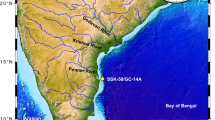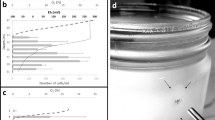Abstract
Remanent magnetism in marine sediments has been used extensively over the past twenty years to calibrate the geological time-scale, study geomagnetic reversals and secular variation, and measure the rates of seafloor spreading. Although these sediments may contain different magnetic minerals, magnetite is the most commonly observed and magnetically stable phase, and its size, shape and post-depositional fate affect the magnetic remanence of the sediments. Biogenic magnetites are single-domain, with a high natural magnetic remanence (NRM), and have been suggested as a significant source of magnetic remanence in marine sediments. We have studied surface sediments from the Santa Barbara Basin and report the occurrence of living magnetotactic bacteria and the deposition of biogenic ultra-fine-grained, single-domain magnetite. Using a novel extraction technique, transmission electron microscopy and SQUID magnetometry, we show that these bacteria and the magnetite they produce are the major source of stable remanent magnetism in these sediments.
This is a preview of subscription content, access via your institution
Access options
Subscribe to this journal
Receive 51 print issues and online access
$199.00 per year
only $3.90 per issue
Buy this article
- Purchase on Springer Link
- Instant access to full article PDF
Prices may be subject to local taxes which are calculated during checkout
Similar content being viewed by others
References
Karlin, R. & Levi, S. Nature 303, 327–330 (1983).
Lund, S. P. et al. Eos 64, 683 (1983).
Karlin, R. & Levi, S. J. geophys. Res. 90, 10373–10392 (1985).
Leslie, B. et al. Eos 65, 957 (1984).
Chang, S.-B. R. & Kirschvink, J. L. in Magnetite Biomineralization and Magnetoreception Organisms (eds Kirschvink, J. L. et al.) 647–669 (Plenum, New York, 1985).
Towe, K. M. in Magnetic Biomineralization and Magnetoreception in Organisms (eds Kirschvink, J. L. et al.) 167–181 (Plenum, New York, 1985).
Butler, R. F. & Banerjee, S. K. J. geophys. Res. 80, 4049–4058 (1975).
Blakemore, R. P. A. Rev. Microbiol. 36, 217–238 (1982).
Towe, K. M. & Moench, T. T. Earth planet. Sci. Lett. 52, 213–220 (1981).
Frankel, R. B. A. Rev. Biophys. Bioengng 13, 85–103 (1984).
Fuller, M. et al. in Magnetite Biomineralization and Magnetoreception in Organisms (eds Kirschvink, J. L. et al.) 103–151 (Plenum, New York, 1985).
Chang, S.-B. R., Stolz, J. F. & Kirschvink, J. L. Phys. Earth planet. Inter. (in the press).
Cisowski, S. Phys. Earth planet. Inter. 26, 56–62 (1981).
Nelson, J. & Jannasch, H. Archs Microbiol. 136, 262–269 (1983).
Blakemore, R. P. et al. Geomicrobiol. J. 4, 53–71 (1984).
Savrda, C. E. et al. Bull. Am. Ass. Petrol. Geol. 68, 1179–1192 (1984).
Demitrack, A. in Magnetite Biomineralization and Magnetoreception in Organisms (eds Kirschvink, J. L. et al.) 625–645 (Plenum, New York, 1985).
Von Dobeneck, T. et al. Int. Ass. Geomagnetism Aeronomy Meet. Abstr. 1, 214 (1985).
Petersen, N., von Dobeneck, T. & Vali, H. Nature 320, 611–615 (1986).
Frankel, R. B. Nature 320, 575 (1986).
Author information
Authors and Affiliations
Rights and permissions
About this article
Cite this article
Stolz, J., Chang, SB. & Kirschvink, J. Magnetotactic bacteria and single-domain magnetite in hemipelagic sediments. Nature 321, 849–851 (1986). https://doi.org/10.1038/321849a0
Received:
Accepted:
Issue Date:
DOI: https://doi.org/10.1038/321849a0
This article is cited by
-
Indian Ocean glacial deoxygenation and respired carbon accumulation during mid-late Quaternary ice ages
Nature Communications (2023)
-
Magnetotactic bacteria and magnetofossils: ecology, evolution and environmental implications
npj Biofilms and Microbiomes (2022)
-
Rock magnetism of quartz and feldspars chemically separated from pelagic red clay: a new approach to provenance study
Earth, Planets and Space (2018)
-
Coupled microbial bloom and oxygenation decline recorded by magnetofossils during the Palaeocene–Eocene Thermal Maximum
Nature Communications (2018)
-
Distribution and diversity of magnetotactic bacteria in sediments of the Yellow Sea continental shelf
Journal of Soils and Sediments (2018)
Comments
By submitting a comment you agree to abide by our Terms and Community Guidelines. If you find something abusive or that does not comply with our terms or guidelines please flag it as inappropriate.



